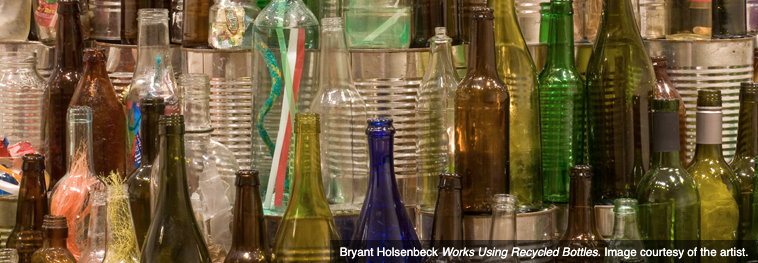A project in partnership with the Catherine J. Smith Gallery and other campus partners, funded in part by Appalachian’s Sustainability Council Competitive Arts Grant.
The Turchin Center for the Visual Arts and the Catherine Smith Gallery partner with environmental artist Bryant Holsenbeck to create an installation project that will encourage reflection and raise awareness of environmental issues. Holsenbeck will be on campus to complete a residency in conjunction with this exhibition. The project she will create at Appalachian State University will utilize recycled materials collected by contributing individuals, organizations and campus partners and will be constructed with community participation. Components of the residency incorporated workshops, classroom visits, volunteer opportunities, and a public lecture.
Bryant has been producing works with recycled materials for over ten years and is skilled at bringing together groups of people, young and old, to build projects that promote sustainable practices in communities and in homes.
Please make sure to view our student and community member contributions of crows. Almost 100 artists attended a workshop led by Bryant in February and are hard at work with their own creations. The end result will be a Murder of Crows that will be a part of the installation. Make sure to visit our Flickr page to view images.

About the artist
Bryant Holsenbeck, an environmental artist, has been documenting the “stuff” of our society that we use once and throw away for over a decade. Americans create more garbage, per capita, than any other culture, yet we are blind to our waste. She collects many things, among them, bottle caps, credit cards, pencils, shoes and chopsticks. Bryant uses these everyday items to make work, which transforms the objects, which surprise us. We are used to using “stuff” once and then throwing it away. We may throw it away, but Bryant’s work makes her aware of its continual impact.
Bryant began her arts career as a basket maker. Since that time she has evolved into an environmental artist who makes large-scale installations that document the waste stream of our society. She has shown her work and taught throughout the United States. She has been the recipient of two North Carolina Arts Council Fellowships, a Project Grant and an NEA Arts and Learning Grant that she worked on in collaboration with the Chapel Hill Public Arts Commission. She is currently attempting to live one year without disposable plastic and writing a blog about it entitled “The Last Straw: A Reluctant Year Without Disposable Plastic.” Most recent past projects are AGAIN AND NEVER AGAIN: Can We Co-Exist with Ourselves? at Guilford College, Greensboro, NC and a 28 foot recycled mandala for blueshere: earth art expo, sponsored by the Halsey Institute of Contemporary Art in Charleston, S.C. She is a community artist who likes to work with groups of people to make large-scale installations using the “stuff” of our society. She is also an independent studio artist who makes books, birds, and sculptures out of recycled materials.
This exhibition includes an artist residency along with lectures and workshops.
![CJSlogo [Converted] Catherine J Smith Gallery logo](https://tcva.appstate.edu/wp-content/uploads/2024/04/CSGLog_0.jpeg)

Additional resources
- Flickr Installation images
- The ‘STUFF’ of Our Lives
- A Murder of Crows – On Flickr
- Bryant Holsenbeck – Official website.
- The Last Straw: A continued quest for life without disposable plastic – Blog by Bryant Holsenbeck.
- Catherine J. Smith Gallery – Official website.
- Appalachian State University Sustainability Council
- Ivy Colleges Shunning Bottled Water Jab at $22 Billion Industry – Bloomberg, March 7, 2012.
